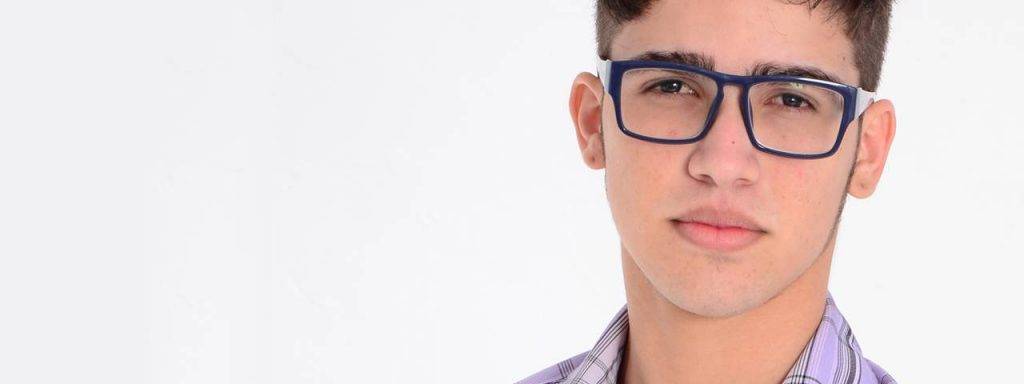Myopia (nearsightedness) progression in children doesn’t only result in needing stronger glasses, but also leads to serious sight-threatening eye conditions.
Below are the most common eye diseases caused by high myopia. Controlling myopia in childhood significantly reduces the risk of your child experiencing these sight-threatening eye conditions.
Retinal detachment
Children with mild myopia ( −1.00 to −3.00 diopters) are 4 times more likely to experience retinal detachment.
Children with moderate to high myopia (above −3.00 diopters) are 10 times more likely to experience retinal detachment.
A retinal detachment can occur when fluid travels through a retinal tear and causes the retina to detach from the other tissues in the back of the eye. When this occurs, the retinal blood supply is cut off and the retina is unable to function properly.
Symptoms of retinal detachment may not be noticeable, but may include sudden vision loss or the presence of:
- Sudden blurred vision
- Floaters
- Flashing lights
- Shadows that block peripheral vision
A retinal detachment is generally treated through laser treatments, surgery, or freezing treatments (cryotherapy) to repair the retinal tear and reattach the retina to the back of the eye.
Myopic macular degeneration (MMD)
Children with high levels of myopia (above −7.00 diopters) are at a higher risk for developing myopic macular degeneration (MMD).
Myopia occurs when the eyeball grows too long from front to back (axial length). High levels of myopia can cause the retina to stretch— leading to structural damage and tears in the macula, the center of the retina. When tears form in the macula, it can cause bleeding under the retina and permanent central vision loss.
Similar to age-related macular degeneration (AMD), there are two different types of MMD: dry MMD and wet MMD.
Dry MMD causes gradual central vision loss, while wet MMD can cause rapid central vision loss.
Symptoms of MMD include:
- Distorted vision- lines appear wavy
- Empty spots within central vision
- Impaired color vision
- Eye adjustment difficulties when moving between two areas that contain different lighting (low light and bright light)
Myopic macular degeneration can develop at any age, but generally affects adults ages 30 to 40.
While there is currently no treatment for dry MMD, wet MMD is typically treated with anti-VEGF injections and laser surgery.
If your child has worsening myopia, contact an eye doctor near you who can discuss the eye health benefits of myopia management.
SEE RELATED: Myopia and Vision Therapy
Glaucoma
Children with mild to moderate myopia are twice as likely to develop glaucoma, while children with high myopia are 3 times more likely to develop this sight threatening disease.
Glaucoma is one of the leading causes of blindness, worldwide.
Glaucoma develops when the fluid within the eye is unable to drain properly and the pressure within the eye rises. Overtime, the increased intraocular pressure (IOP) presses on the optic nerve and causes irreversible damage and permanent vision loss.
Symptoms of glaucoma include:
- Severe eye pain
- Blurred vision
- Seeing halos around lights
- Nausea and vomiting
As myopia progresses to higher levels, structural changes within the retina occur, causing the macula to thicken and increasing the risk of glaucoma.
Cataracts
Children with moderate to high myopia are five times more likely to develop cataracts at an earlier age.
Cataracts occur when the eye’s naturally transparent lens becomes cloudy and opaque, making it difficult to see clearly.
Symptoms of cataracts include:
- Blurry or cloudy vision
- Increased sensitivity to glare
- Seeing halos around lights
- Poor night vision
- Colors appearing less vibrant
- Double vision
While researchers are still studying the exact correlation between high myopia and cataract development, studies show that increasing axial length in myopic eyes may inhibit essential nutrients from reaching the back of the eye’s lens. This can cause protein build-up and result in a cataract.
Cataract surgery is recommended when cataracts become so severe that they begin to impact daily functioning. During cataract surgery, the cloudy lens is removed and replaced with an artificial clear lens.
This procedure may be more complicated for patients with high myopia and can lead to unsuccessful surgical results.
What is myopia management?
Myopia management is a program designed for children and teens with worsening myopia. This program involves the use of specialized lenses or eye drops that have been proven effective in reducing the rate of myopia progression.
Myopia progression has been shown to increase the risk of sight-threatening eye diseases later in life. To protect your child’s eye health and vision, speak with your child’s optometrist about beginning a program of myopia management.
Myopia management is appropriate for children and teens who present with any degree of myopia— but the sooner you begin the program, the greater your chances for optimal results.
LEARN MORE: Guide to Pediatric Eye Conditions
Schedule an appointment with an eye doctor for a comprehensive eye exam, and to discuss any questions you may have about treating your child’s short-sightedness.









